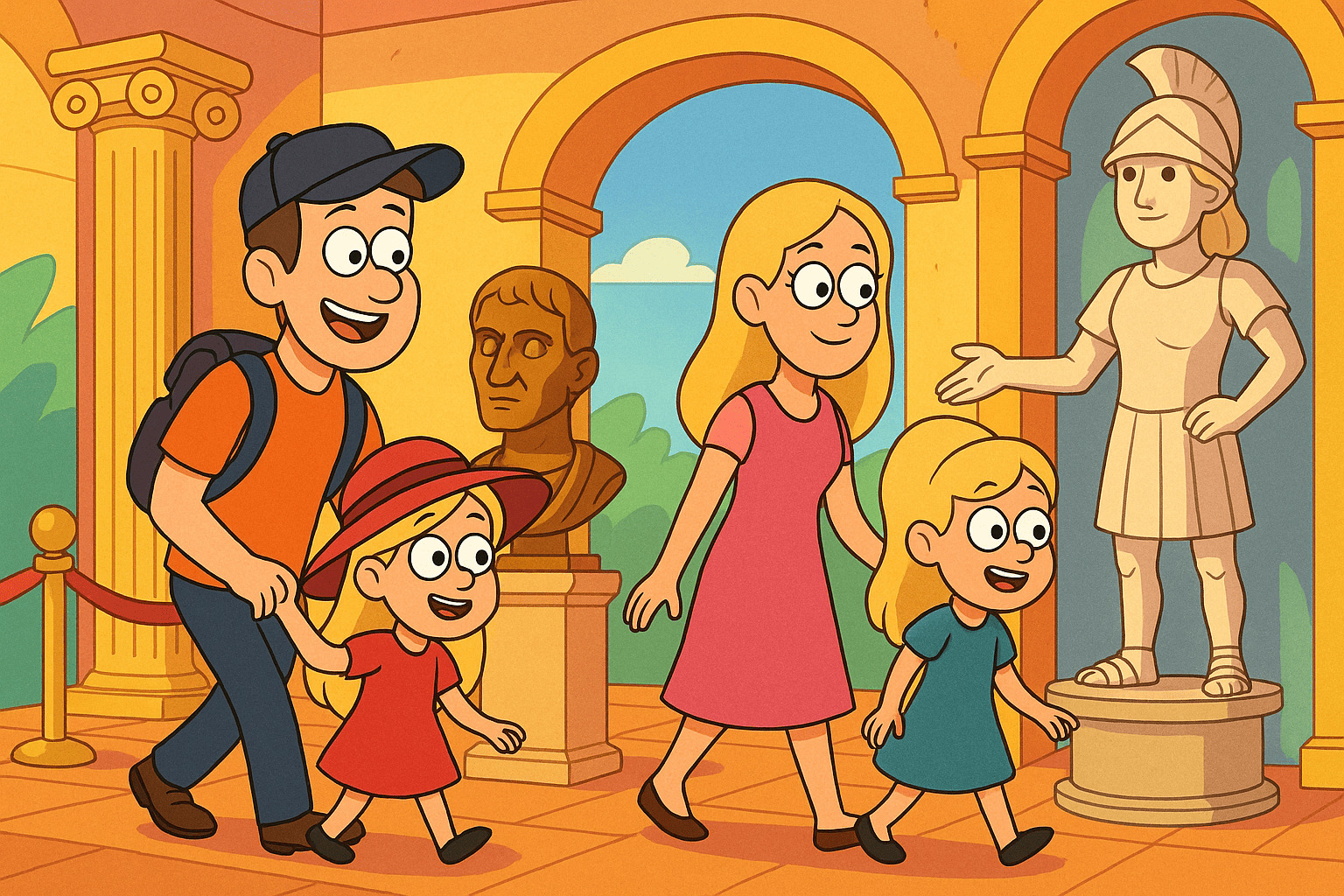Greek Myths in Rome: A Family Guide to Statues & Stories
Turn ancient statues into living stories. Discover Rome’s heroes, gods, and monsters through family-friendly adventures and interactive art missions.

Rome conquered Greece — but Greece conquered Rome’s imagination.
From the 2nd century BCE onward, Roman artists recreated Greek masterpieces, blending myth, empire, and artistry. Today, those stories still stand in marble all over the city — from the Vatican Museums to the Capitoline Hill.
This family guide reveals 10 mythic stops across Rome, combining real history, Greek legends, and playful discovery.
Why Greek Myths Work for Families
Rome is full of history, but for kids, it can feel like a gallery of statues that don’t move. Greek myths fix that, they turn marble into stories. Heroes, monsters, and gods add faces, drama, and fun.
The secret? Treat every statue as part of an interactive family tour. Parents uncover the history, kids get the challenges and fun facts, and everyone plays together through LooksART — the app that makes sightseeing an adventure.
10 Mythic Stops Across Rome
1. Laocoön and His Sons
What to see: Laocoön and his two sons attacked by sea serpents — a masterpiece of emotion and movement.
Myth: The Trojan priest warned his people against the Greek wooden horse. The gods punished him for revealing the truth.
Facts:
- Created by Agesander, Athenodoros, and Polydorus of Rhodes (1st century BCE).
- Discovered in 1506; Michelangelo called it “a miracle of art.”
- Inspired countless Renaissance artists.
Family activity: Ask kids: “Would you have listened to Laocoön’s warning?”
2. Apollo Belvedere
What to see: Apollo just after firing his arrow, calm and victorious.
Myth: After slaying the serpent Python, Apollo claims Delphi as his shrine.
Facts:
- Roman marble copy of a Greek bronze by Leochares (ca. 330 BCE).
- Once seen as the ideal of classical beauty.
- Taken by Napoleon to Paris in 1797, returned in 1815.
Family activity: Recreate Apollo’s stance — can you balance like a god?
3. Tiber Apollo
📍 Museo Nazionale Romano (Palazzo Massimo)
What to see: A serene statue of Apollo, god of music and prophecy, found in the River Tiber.
Myth: The god of light and order, Apollo guided artists, healers, and oracles.
Fun fact: This is a Roman copy of a 5th-century BCE Greek original.
Family activity: Find Apollo’s lyre — can you spot it?
4. Dying Gaul
What to see: A wounded Galatian warrior, proud even in defeat.
Myth/history: The Greeks admired courage, even in enemies.
Fact: Roman copy of a Greek bronze from Pergamon (3rd century BCE).
Family activity: Ask: “Why is sadness heroic here?”
5. Capitoline Venus
What to see: The Roman Aphrodite, modestly covering herself as she rises from the sea.
Myth: Born from sea foam, she embodies love and beauty.
Fact: One of the most copied statues in European art.
Family fun: Talk about what beauty means today – inside and out.
6. Cupid and Psyche – Capitoline Museums
What to see: Eros (Cupid) tenderly embracing Psyche.
Myth: A mortal girl’s love triumphs over divine trials.
Fact: Roman copy of a Greek Hellenistic original.
Family play: Retell the story as a modern fairy tale.
7. Apollo and Daphne – Galleria Borghese
What to see: Bernini’s marble masterpiece capturing Daphne turning into a laurel tree.
Myth: Apollo, struck by love, chases the nymph who becomes nature itself.
Fact: Completed in 1625 — inspired by Ovid’s Metamorphoses.
Family tip: Walk around to see bark turning from skin — a moving sculpture!
8. Aeneas, Anchises & Ascanius
What to see: Aeneas carries his father from burning Troy.
Myth: Son of Venus, Aeneas links Greek heroes to Rome’s founding myth.
Fact: Early Bernini work showing strength and duty.
Family fun: Spot the three generations — hero, father, and son.
9. Wounded Amazon
What to see: A brave warrior woman in battle stance.
Myth: Amazons fought alongside and against Greek heroes.
Fact: Roman marble copy of a lost Greek bronze (c. 430 BCE).
Challenge: Imagine your own Amazon warrior name!
10. Hermes (Antinous)
What to see: Hermes, the messenger god, portrayed as Antinous, Emperor Hadrian’s beloved.
Myth: God of travelers, boundaries, and wit.
Fact: Shows how emperors merged divine and human ideals.
Family activity: What message would you deliver if you were Hermes?
Parent Survival Tips
- Alternate between outdoor piazzas and indoor museums.
- Carry sketchpads — myths inspire quick doodles.
- Share stories the night before to spark curiosity.
- Always have snacks + water; interactive tours can be long.
- Bright clothes help kids stand out in crowds.
- Use LooksArt as your game master: unlock missions, puzzles, and myth stories in real time.
Final Takeaway
Greek myths in Rome aren’t just art — they’re living adventures.
Through LooksART, your family doesn’t just look at history — you play inside it.
- Kids become heroes and explorers.
- Parents become narrators and guides.
- Every marble becomes a shared memory.
✨ Rome becomes your family’s own epic.